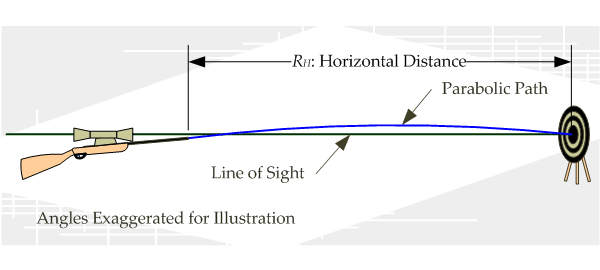Many moons ago, when we first studied the
basics of rifling on this blog, there was mention of the term
twist rate of a barrel. The twist rate is defined as the length of the barrel required for the bullet to make one complete turn in the barrel. For instance, a standard M16A2 barrel makes 1 turn for every 177.8 mm. length of barrel.
As we studied earlier in this blog, the whole purpose of rifling is to spin the bullet as it comes out of the barrel, therefore stabilizing the bullet as it flies through the air. This gives the firearm its accuracy. Different bullet shapes will need different twist rates. For instance, large diameter bullets have more inherent stability because the large diameter has gyroscopic inertia, whereas long thin bullets need to be spun faster. Therefore, a rifle firing a round lead ball can get away with 1 turn in 60 inches rifling, whereas a rifle firing a longer conical bullet (such as the M16) needs a rifling rate of something like 1 turn in 7 inches (177.8 mm.). On the other hand, having too high of a twist rate increases barrel wear and can tear the bullet's jacket apart while flying through the air. Therefore, one must pick a barrel with a twist rate that keeps the bullet stable in the air, without causing performance issues for the bullet or barrel.
To determine the optimum twist rate of a barrel, several people have developed various rule-of-thumb equations over the years. The first equation we will study is the Greenhill formula, which was developed by Sir George Greenhill, professor of mathematics at the Royal Military Academy in London, way back in 1879. This formula is completely empirical (i.e. the professor made several observations and came up with an equation that approximately fit the observations, rather than having a complete scientific explanation of how the formula was derived). The formula was originally developed for rifled artillery, but was found to work just fine for small-arms bullets as well. The original Greenhill formula was:
Twist = C * D * D / L
where
D = Diameter of the bullet in inches
L = Length of the bullet in inches
C = A constant (defined to be 150 in the original equation, but read on for modern modifications)
Of course, this equation only worked for lead-core bullets, so it was modified a little to account for bullets made of other materials as well. The new reworked formula is:
Twist = C * D * D / L * sqrt(SG / 10.9)
where
sqrt = Square root
SG = Specific gravity of the bullet material. For a lead core bullet, SG = 10.9, therefore the right part of the equation evaluates to 1. For other materials, the value of SG is as follows: Copper = 8.5, Brass = 8.9, Steel = 7.8.
Say we have a .308 Winchester cartridge (the commercial version of the NATO 7.62x51 mm. cartridge) with a 190 grain Sierra Matchking bullet (manufacturing number #2210). This bullet has a length of 1.375 inches and a diameter of .308 inches. Assuming SG = 10.9 for lead core bullet, we have:
Twist = 150 * 0.308 * 0.308 / 1.375 * sqrt(10.9 / 10.9)
Doing the math with a simple calculator gives us the result of 10.3488 inches, which means a rifling rate of about 1 turn in 10 inches should work out for us. This is why many rifles that use .308 Winchester caliber come with barrels with a twist rate of 1 turn in 10 inches.
While the value of C = 150 worked for bullets in Greenhill's day, it didn't work so well with modern bullets that travel at much faster speeds. In fact, as far back as 1929, a book called The Textbook of Small Arms which was published in England, stated that: "In actual practice Greenhill's figure of 150 can be increased safely to 200 and still control the bullet". A more modern rule of thumb is to assume C = 150 for bullets that travel at speeds less than 2800 feet/sec and for bullets that travel faster than 2800 feet/sec, C = 180 can be assumed. Another way to compute C, which was proposed by Les Bowman in Gun Digest, 1962, is to use the following equation for C:
C = 3.5 * sqrt(V)
where
V = velocity of the bullet in feet/sec.
Note that in Greenhill's time, the average velocity of a bullet was around 1800-1850 feet/sec, which would give us C = 150 approximately, if using Bowman's method to calculate C. Similarly, using a more modern velocity of 2800 feet/sec would give us C = 185 per Bowman's calculation.
With Bowman's alteration to the formula, the new Greenhill formula can be written as:
Twist = 3.5 * sqrt(V) * D * D / L * sqrt(SG / 10.9)
Let us work out the twist rate needed to fire a cartridge that shoots the same bullet as above at a velocity of 2500 feet/sec. In this case:
Twist = 3.5 * sqrt(2500) * 0.308 * 0.308 / 1.375 * sqrt(10.9 / 10.9)
Again, doing the math with our trusty calculator, we get about 12.0736 inches or about 1 turn in 12 inches.
In the next article, we will study some more rule-of-thumb equations to calculate barrel twist rates.

















